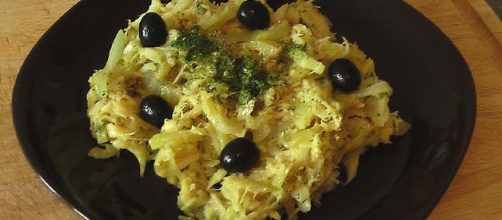Portuguese food is being discovered by tourists and foreigners, just like her big cities, Lisbon and Oporto. And mirroring the natural and cultural diversity of the country, people are now aware that there is a lot more than the Portuguese Stew (prepared all around the country) or the Francesinha (a specialty from Oporto). Some dishes try to compete with each other to find which is the most heavy to the stomach; others are surprisingly soft and comforting. But all are quite tasty, taking on the variety of the ingredients and the herbs used. And then you have the wine, red, white, rosé and whatever you wish.
Find out 5 of the best Portuguese food specialties.
Bacalhau àBrás
Codfish (in Portuguese, "bacalhau") is the national ingredient of Portugal. It's not right to say that it's the national dish because, as they say, there are 1001 ways of cooking this fish brought from the cold waters of Newfoundland, across the Atlantic, or Norway. To make it last the long travel to portuguese kitchen, ancient fishermen started to immerse it in salt; that became a portuguese uniqueness.
"À Brás" is just one of those 1001 ways: shredded cod, sauteed, and together with fried potatoes and onion. Above this, black olives, parsley and beaten eggs. Don't forget a good white wine.
Açorda Alentejana
If you travel further south, you'll quickly find how amazing it is that in such a small country there are so much cultural and gastronomic differences.
The southern province of Alentejo is quite plain, unlike the North, and it's climate is warmer. It's food mirrors this, taking everything the land provides in a creative way (as does therenowned wine of Alentejo). One can find also using herbs as a sign of Islamic influence; these lands were ruled by Muslim powers between the 8th and 13th centuries.
The Açorda (pronounce "ah-ssorda") of Alentejo is something between a soup and a dish. You take mashed bread in a plate with water, insert eggs, olive oil, coriander, and even cod fish to make it richer, and there it is. The Açorda is never served hot, and if you take one at lunch on a hot summer day, you'll understand why.
Arroz de Sarrabulho
In Northern Portugal, people make themselves proud of eating more - and "better" - than their counterparts in the south.
A good example of this is the "Sarrabulho Rice", which is rice cooked in blood. This is a pork dish, where pork parts are marinated in red wine and cumin and then cooked in blood. If you think somewhat disgusting the idea of taking the pork's blood to cook, please note that a lot of Portuguese (mainly from the South) would agree with you and not eat this. However, it's delicious. It goes along well with Vinho Verde, the typical effervescent wine from the Minho province.
Caracóis (Snails)
If you say it in French, "escargots", it would sound better and more "chic" than in English. But the Portuguese don't quite care about it. They cook it and take as a tidbit, together with a fine beer, surrounded by friends.
In spite of the publicity that has been given to it by someBritish media, this is still more associated with the Mediterranean, slow lifestyle. Make no confusion; just like the "Sarrabulho", there are some Portuguese who don't take the idea of eating this gastropod.
Feijoada à Transmontana
Translated, this means "bean stew from the province of Trás-os-Montes", in the North. This has way more than beans, though; the recipe may vary according to the restaurant, but you can expect every part of pork to be in it.

